NBA Season Preview 2021-2022: Western Conference
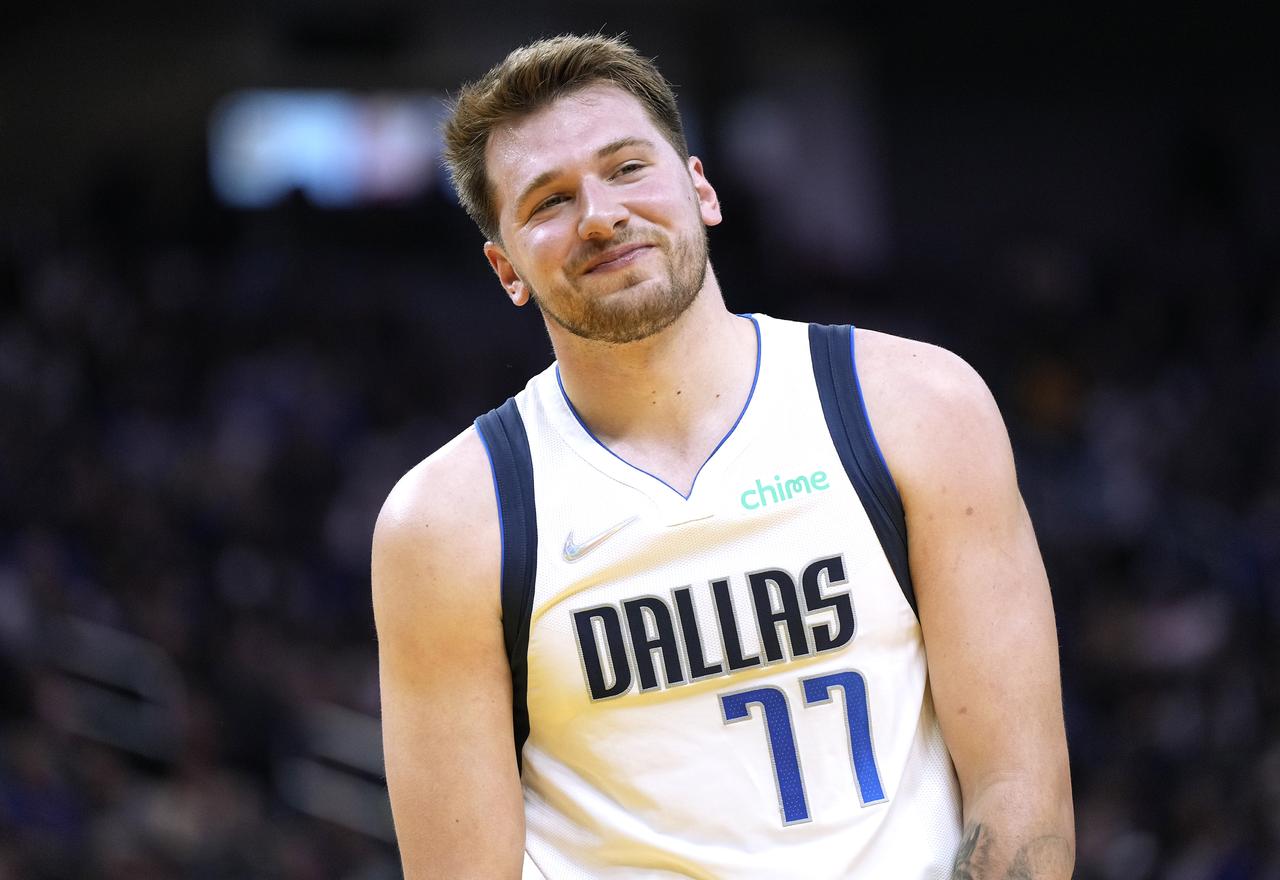
Dallas Mavericks
Added: Christian Wood, JaVale McGee, Tyler Dorsey, McKinley Wright (Two-Way), Jaden Hardy
Lost: Jalen Brunson, Sterling Brown, Trey Burke, Boban Marjanovic, Marquese Chriss, Moses Wright
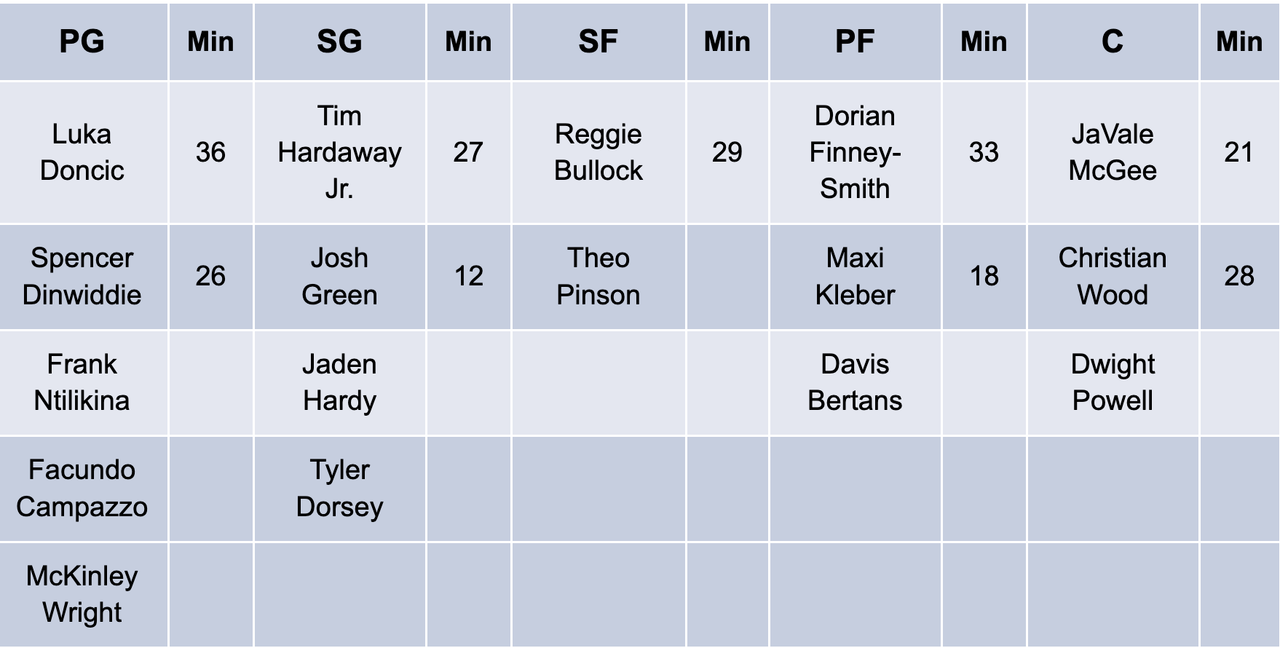
Best Case Scenario:
The Mavericks are coming off of a surprise Western Conference Finals berth. A healthy Luka Doncic assures a return to the playoffs, but threatening a deep run depends on the rest of this roster. Spencer Dinwiddie must take the playmaking burden with the departure of Jalen Brunson, and he needs to find a way for his 40.0% three-point marksmanship with Dallas to persist.
Tim Hardaway Jr. is back after suffering a broken foot in January, and his scoring was missed. Christian Wood has proven his scoring ability, and he has a chance to help a winning team. JaVale McGee needs to justify the decision to value his interior defense and finishing as he nears age 35. Losing Brunson hurt, but the pieces could still fit together well enough for the Mavericks to take a slight step forward.
Worst Case Scenario:
The Mavericks’ ceiling relies on the 16 players who aren’t Doncic. McGee addresses issues, but relying on him in a starting role at his age is risky. Additionally, Brunson’s secondary scoring likely goes unmatched. Dinwiddie and Hardaway Jr. have proven to be inefficient scorers and a drastic improvement isn't likely. Wood scores efficiently, but he might not be able to influence winning. Between Dinwiddie, Hardaway Jr., and Wood, none are quality defenders. With their acquired and returning players, Dallas could be more talented than last season. Unfortunately, the talented secondary scorers might not be a clean fit alongside Doncic.
Is Luka Doncic the deserving MVP favorite?
Doncic is entering his fifth NBA season in the best shape of his career. While there have been incremental improvements in his decision-making, shooting, and isolation scoring, his stats have remained remarkably similar over the last three seasons. But there are valid reasons to believe Doncic’s numbers could be improved. He started last season in questionable shape and averaged 25.1-8.8-8.7 on 43.5% shooting over in his first 30 games. In better shape over the final 50 games, Doncic averaged 31.4-9.5-8.0 on 46.8% shooting.
Additionally, Doncic’s stats could improve as a result of sharing the court with one less ball handler. Combining his increased opportunity with the expected progression from a fifth-year player, it’s easy to see why Doncic is the betting favorite for MVP. If improvement is limited and he fails to play more than 66 games for the third straight season, then winning those honors isn’t definitive, but I wouldn't be willing to bet against it.
Which Mavs are most fantasy-relevant outside of Doncic?
There is fantasy basketball value outside of Doncic, but getting a full read will take at least a couple of weeks of the season. The pecking order was clearer last season with Brunson as the second option and Dinwiddie coming off the bench. But Brunson’s departure along with the addition of Wood and the return of Hardaway Jr. muddies the water.
Wood will not transport his Houston numbers, as his potential minutes next to centers and Doncic should keep his rebounds from approaching 10 per game. His efficiencies figure to rise, but overall volume should fall as his minutes are reduced. 15-8 are conservative estimates this year. Hardaway Jr.’s shooting numbers cratered as he endured a prolonged slump last year, and if those are correctable then he projects around 15.0-3.5-2.0. Dinwiddie will not match Brunson’s scoring in the paint or rebounding, but he should approach 13.5-2.0-4.0 in his role. We will need to wait and see if any of the trio fall above or below these projections.
Denver Nuggets
Added: Kentavious Caldwell-Pope, Bruce Brown, Ish Smith, DeAndre Jordan, Jack White, Christian Braun, Peyton Watson, Collin Gillespie (Two-Way)
Lost: Will Barton, Monte Morris, JaMychal Green, Austin Rivers, Facundo Campazzo, Bryn Forbes, DeMarcus Cousins, Markus Howard
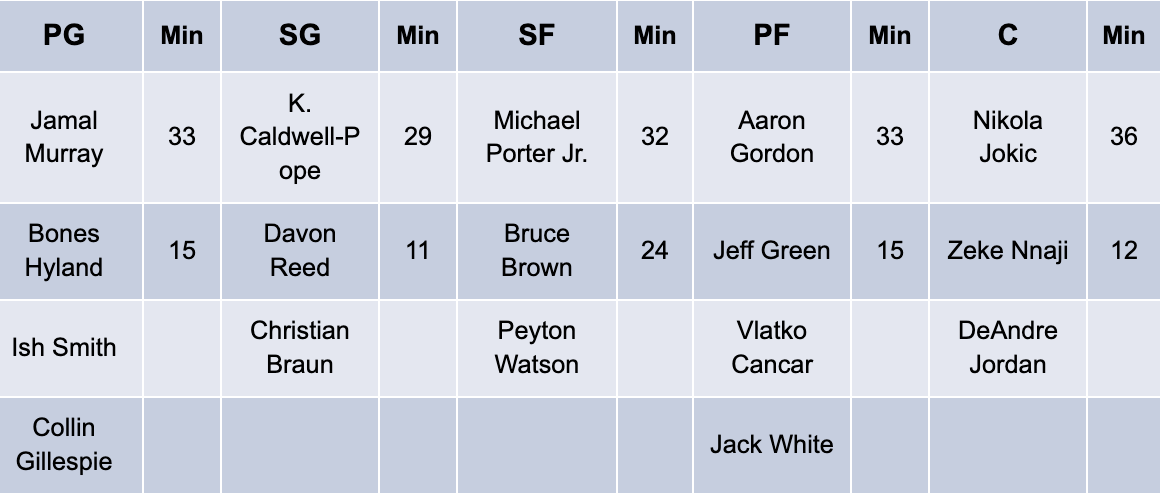
Best Case Scenario:
The Nuggets should improve this season with the returns of Jamal Murray and Michael Porter Jr. Nikola Jokic played almost all of last season without them, establishing a baseline of 48 wins. Murray and Porter Jr. are more talented than Monte Morris and Will Barton were in their roles. Additionally, adding Kentavious Caldwell-Pope and Bruce Brown to fortify the wing rotation gives the Nuggets two high-level role players. With their two All-Star-level talents recovered and available, the Nuggets’ upgraded their ceiling. If Murray and Porter Jr. return to full health this season, the Nuggets can contend.
Worst Case Scenario:
The Nuggets have plenty of injury concerns. Murray and Porter Jr. were both nearing a return at the end of last season, and they’ve participated in preseason contests. Murray is recovering from an ACL tear, and he missed 57 regular season games in the prior two seasons. Porter Jr. runs an even higher risk of re-injury following his third back surgery at 23 years old. He has played in just 38% of his career regular season games. Additionally, there has been a great deal of physical strain for Jokic in the last two years and he spent this summer participating in EuroBasket. Ultimately, the Nuggets need their big three to be at 100% for them to threaten title contention.
How close can Nikola Jokic come to reaching his MVP stats?
Jokic’s stats from his first MVP season, which featured 48 and 61 games from Murray and Porter Jr., respectively, and his second MVP season, with just nine games from Porter Jr., were remarkably similar. As the fulcrum of this Nuggets offense, Jokic’s numbers should remain fairly stable. But Murray and Porter Jr. are too talented for their returns not to impact the back-to-back MVP.
While both Murray and Porter Jr. are prone to missing time, the duo should share the floor with Jokic more than any other season. Jokic’s boards likely won’t approach 13 per game as Murray and Porter Jr. rebound at a stronger rate than their counterparts from last season. Jokic’s usage could dip to below 30% as well, capping some upside and reducing his career-high 27.1 ppg mark. There is a chance his assists rise with greater surrounding talent, and his shooting splits should also improve as he forces less. The statistical ceiling is not quite as high for Big Honey, but it isn’t noticeably lower either.
Is Aaron Gordon any better than a fringe fantasy option?
Aaron Gordon’s stats received a boost from Porter Jr. and Murray being out. He was cast as a corner shooter and cutter upon arriving in Denver, and his production suffered. Gordon averaged just 10.2-4.7-2.2 on just 17.2% usage in a starting role during his first season with the Nuggets, but his value rose last season. He created more and submitted improved averages of 15.0-5.9-2.9 on 19.2% usage. However, Gordon’s stats project to decline as the Nuggets welcome their stars back.
Gordon posted solid offensive numbers on challenged Magic teams, but he is not likely to pop in a supporting role. Gordon creates balance with Porter Jr. in the front court–he defends the scoring forward while Porter does the heavier lifting offensively. This relegates Gordon to corner shooter and cutter again. His usage likely dips to 17% as a result, with his scoring reverting back to the 11 per game or less it was two seasons ago. Additionally, sharing the floor with Porter Jr. affects his rebounding stats, and he could average around 4.5 instead of 6.0. Gordon and Caldwell-Pope are both in this lineup because of their defense, and the fourth and fifth starters really should only be options in deep leagues as a result.
Golden State Warriors
Added: Donte DiVincenzo, JaMychal Green, Ty Jerome (Two-Way), Anthony Lamb (Two-Way) Patrick Baldwin, Ryan Rollins
Lost: Gary Payton II, Otto Porter, Nemanja Bjelica, Damion Lee, Juan Toscano-Anderson, Chris Chiozza
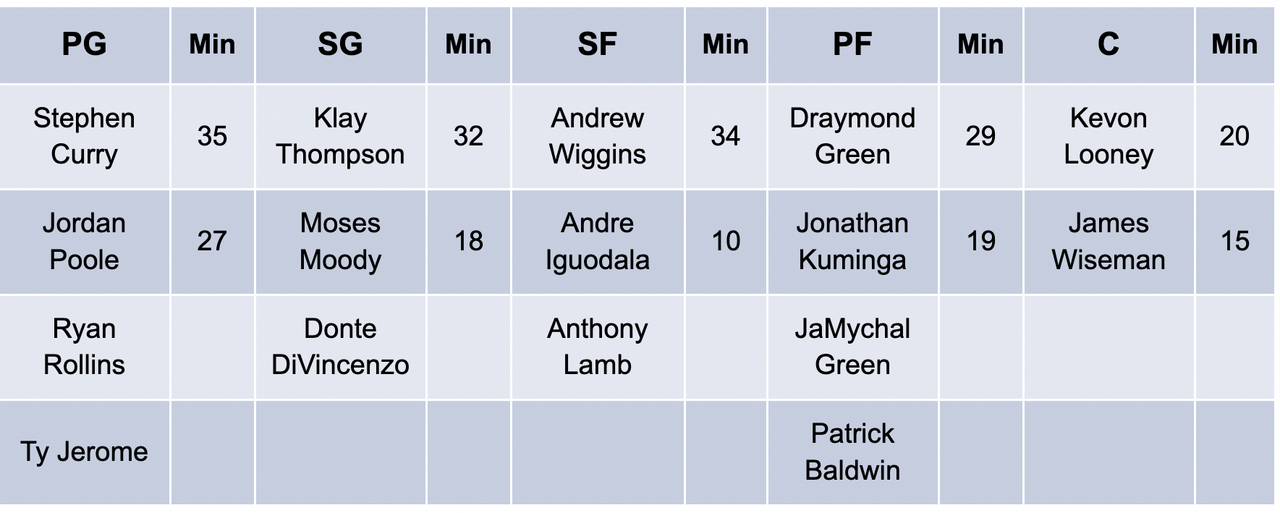
Best Case Scenario:
The defending champions entered the playoffs with Stephen Curry recovering from a sprained foot ligament, Klay Thompson still far from 100% after two and a half years removed from live action, and Draymond Green also out of sync after missing most of the second half of the season. Golden State should arrive at the postseason with all three players healthier than they were for that championship run, and they can improve on the margins. While Otto Porter and Gary Payton II left this off-season, Jonathan Kuminga and Moses Moody are likely more impactful in their minutes during their sophomore seasons. The Warriors should be deeper than they ever have been as they effectively add Donte DiVincenzo, JaMychal Green, and James Wiseman onto their roster. If their main three extend the back end of their primes one last time, then they will be well-suited to add a fifth title.
Worst Case Scenario:
Thompson is 32, was not able to recover athletically after his layoff, and should be more of a specialist than he ever has been. Green, also 32, has become even more limited offensively, and his defense will suffer as his athleticism continues to decline. Finally, Curry is 34 and will still play at a high level, but he’s due for age-based regression. And while their depth is talented, many of the young players are unproven. Moody, Kuminga, and Wiseman’s contributions are largely theoretical, and the former two were excluded from the playoff rotation last season. Payton II was in their best lineup against the Celtics and nobody will be able to emulate his guard defense. The Warriors’ roster stands on two extreme ends of the age spectrum, and both groups could be too far outside of their primes to mesh.
Is Jordan Poole due for statistical regression?
Jordan Poole could submit lesser numbers as a function of fewer available opportunities this season. He played without Thompson for the first 32 games of last season and averaged 17.5 ppg on 13.6 field goal attempts in 30 minutes per night. But when Thompson arrived to reclaim what was initially a limited role, it negatively impacted Poole. In the 23 games that they played together until Curry’s regular season ended, Poole’s production dipped to 15.2ppg on 10.6 field goal attempts in 27.1 minutes per game.
Poole is most valuable when Curry is out, and Curry missed 18 games last season while Thompson was on the mend for 50. Poole will not be needed as a volume scorer if the Warriors remain fairly healthy. Even his heavier-usage bench minutes could be more balanced as Golden State’s reserves feature more scoring options. Barring a long-term injury for Curry, it does appear likely that Poole’s stats dip slightly when many are expecting more from him. Look for him to hover around 17.0-3.0-3.5 overall in what is still a key sixth-man role, but don’t expect more if the Warriors remain healthy.
Is there hope for Draymond Green to recover as a fantasy basketball asset?
Green’s has increasingly become more of a fringe fantasy option. The biggest variable that has led to this is an increased reluctance to shoot, and reversing this trend would address the issue. He averaged only 5.6 field goal attempts per game last season, which was a career low as a starter. His 14.3% usage mimicked one of a low-usage role player, and he is more involved offensively than other players who post similar usage. This team is too talented for Green to be a good deal more involved, but driving a couple more times per game and making more than 29.6% of his threes on slightly higher volume would resuscitate his value.
Playing time is another factor that can benefit Green. He sat out 31 games with a lower back disc injury last season and was comfortable sitting out longer than initially suggested to ensure his playoff health. Green’s rest games could increase after receiving only five such games in addition to injury-related absences. He could also play less than the 28.9 minutes per game he averaged last season. The potential for fewer center minutes would impact his value, as Green’s career-high 13.8 total rebound percentage from last season stemmed from increased center minutes. Green will be underrated if he plays 70+ games at 30 minutes per night and his offense recovers. But if that is not the case, then he is likely overrated on name value.
Houston Rockets
Added: Boban Marjanovic, Jabari Smith Jr., Tori Eason, TyTy Washington, Trevor Hudgins (Two-Way)
Lost: Christian Wood, John Wall, Dennis Schroder, Trevelin Queen, Anthony Lamb
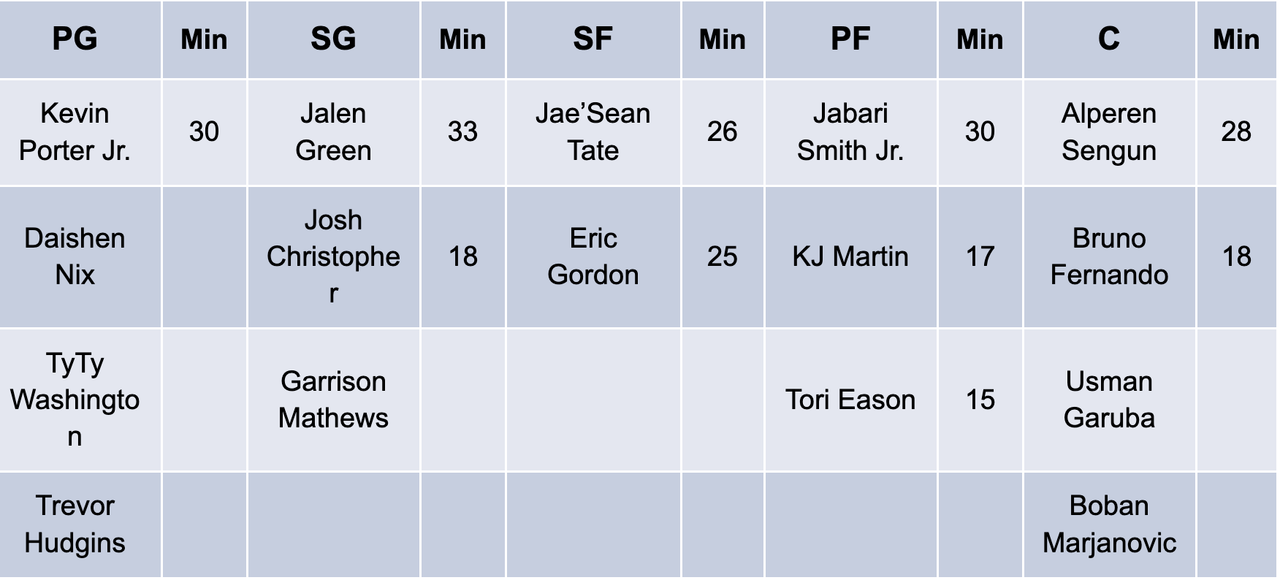
Best Case Scenario:
The Rockets' young core simply needs to grow together. Jalen Green built real momentum after the All-Star break last season and continuing on that trajectory is critical. Jabari Smith Jr. needs to follow the Jaren Jackson Jr. blueprint—become a standout defender and capable jump shooter early before building on that. Alperen Sengun must improve his defense because his abilities as a shooter, finisher, and passer were impressive for a teenager. Either Kevin Porter Jr. or Josh Christopher progressing as shooters, defenders, and distributors in a way that compliments Green long-term is also big. Jae’Sean Tate continuing to be a glue piece, Tori Eason and TyTy Washington flashing as rookies, and getting an asset back for Eric Gordon are also ideal for the Rockets.
Worst Case Scenario:
The Rockets are accumulating young talent and the vision is beginning to form. The concern is that none of the pieces can be true franchise players and that they don’t fit together. Green may post empty-calorie scoring stats without creating much for others in his second season. Smith Jr. could merely be an average shooter and defender as a rookie—cumulatively projecting to be a solid role player instead of a star. Sengun was such a liability in space as a rookie that he became the only NBA player to ever allow Dwight Powell 26-12 in their head-to-head matchup. Porter Jr. and Christopher have expressed some ability to shoot, distribute and defend on some level, but other than Porter Jr.’s shooting, none of those skills have proven to be standouts. If Gordon gets bought out, Eason and Washington get lost in the shuffle, and the main guys don’t take consistent steps, then the Rockets' rebuild has stagnated.
Can Jalen Green take over as the offensive centerpiece?
The most important variable for the Rockets' rebuild revolves around the idea that Green can become their lead guard. Green averaged 14.1-3.3-2.2 on an abhorrent 37.0% from the floor and 28.7% from deep over his first 35 games. There was a steep learning curve, but he continually progressed. Over his last 25 games, Green supplied 22.0-3.7-3.1 on 47.8% from the floor and 39.3% from deep. The more talent a player has, the faster progress is possible. Green certainly qualifies as a talented player who was able to figure it out with more reps.
It’s concerning Green’s ascension came when stats are meaningless—for a tanking team at the end of the season. There will be a challenge to play up to those levels in more competitive play. If he can finish above 20 points while remaining above 44% from the field and 36% from three, then he will be an effective scorer for a long time in this league. That is key for Houston, but Green progressing beyond that and developing comfort in creating for others is what can make him a true lead guard. Look for Green to score above 20 per game in year two as the primary offensive engine, but driving his assists north of five per game will unlock something else within him and his fantasy value.
Can Alperen Sengun be a starting center?
The Rockets knew that they had something in their 16th overall pick during Summer League last year, but Sengun’s long-term prognosis is unclear. Offensively, he has a role in this league: his finishing ability is already an asset, and the way he sees the floor led to some truly impressive passing. The Rockets saw enough to hand Sengun the starting center role this summer without a real backup plan: Wood is gone, and all that remains at the position is some combination of Bruno Fernando, Usman Garuba, and Boban Marjanovic. The starting role now fully belongs to the second-year pro, and he is being given his shot to prove himself in a much bigger way.
Per-36 stats are far from perfect, but Sengun averaged 16.7-9.5-4.5 per 36 as a teenager. With standard progression from an age 19 season into the next, Sengun can roughly average 80-90% of those marks in a 30-minute per night role. His shot looks good mechanically, and if he can connect on threes instead of making a paltry 24.8%, then his chances of matching those numbers improve. Something around 15.0-8.0-3.5 can be expected with Sengun’s opportunity and talent. For the Rockets, he needs to be able to perform consistently, and his defense needs to make the biggest leaps. Sengun was an Enes Kanter-level liability in space last year, and he can either emulate Nikola Jokic’s efficiency of movement with limited mobility or the Rockets' defense craters and he is a career backup, big man. He will be a fantasy basketball asset with his opportunity this season, but he still needs to prove himself as an NBA asset.
Los Angeles Clippers
Added: John Wall, Moses Brown (Two-Way), Moussa Diabate (Two-Way)
Lost: Isaiah Hartenstein, Rodney Hood, Jay Scrubb
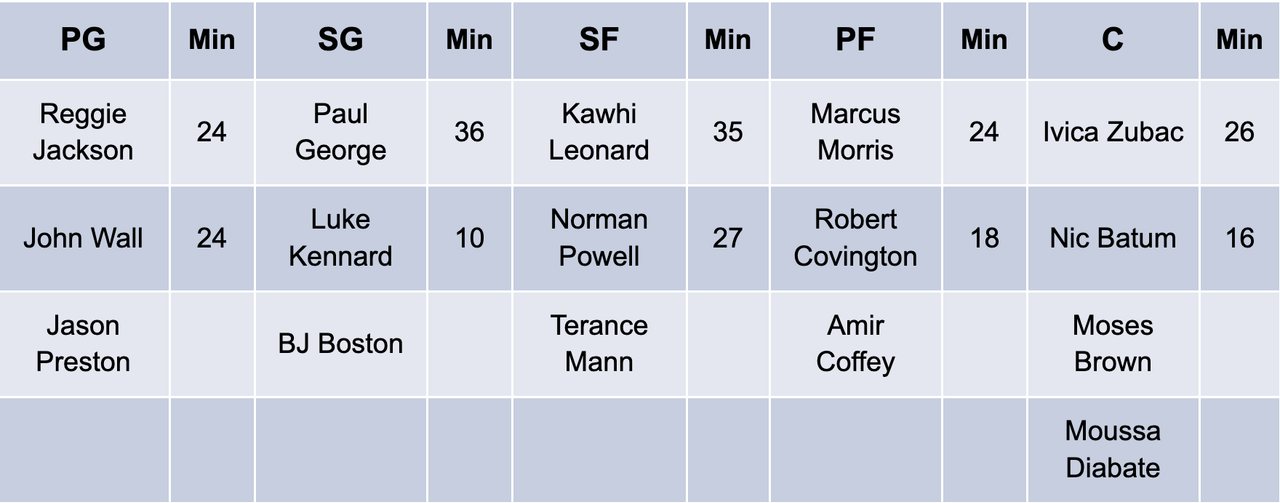
Best Case Scenario:
Last season was mostly a lost one for the Clippers, but the silver lining is knowing that they are the deepest team in the league. The three players who should open as their 10th, 11th, and 12th men all averaged over 22mpg last season, and moving any of the trio up would bump a former starter from the rotation entirely. John Wall may not start, and Norman Powell will come off of the bench following a campaign where he nearly averaged 20 points per game. Adding two of the best five wings in the game to a .500 team heightens championship aspirations. Their organization mortgaged its future and assembled a $336.5 million payroll. Their window is right now, and this could be the best Clippers team ever assembled.
Worst Case Scenario:
The scary part of being all-in is how badly things can turn if the risk does not pay off. With George and Leonard both possessing team options following next season as they progress into their 30s, their best window to win is this season. The Thunder either own or can swap each of the Clippers’ next four draft picks, and making one additional move would mortgage their entire future. This massive risk hinges on the health of Leonard, who has played 43.4% of his regular-season games over the last five seasons, and George, who has played 54% of his regular-season games as a Clipper. Steve Ballmer has played the Clippers’ hand, and we need to wait for the result.
Can Norman Powell avoid statistical regression?
Powell is firmly behind Leonard and George on the wing, and there is no conceivable argument for him taking their minutes when they are available. But he might be too good to keep off the floor after averaging 19.0ppg on nearly 42% from three while playing respectable defense, and there are other factors working in his favor as well. When either Leonard or George rests, they should be replaced in the lineup by Powell. With the way the two stars have been empowered to rest and take time to return from somewhat minor injuries, there is a path for Powell to start 30 or more games as the secondary scoring option.
Additionally, Powell may see heavier sixth-man minutes than expected, as he is one of their best five players. He brings more to the team than any power forward option, and it could become commonplace for Powell to close games with Leonard and George manning the forward spots. Powell’s stats should remain more stable than expected. His 32.4 minutes per night or 23.0% usage will dip, but if he can average 29 minutes at 21% usage still, there is a path for him to still average 18.0-3.0-2.0.
Is Reggie Jackson or John Wall the better fantasy basketball option?
Jackson edges Wall as a shooter due to late career improvements, but neither should be lauded after Jackson made just 32.6% of his threes in a heavy role last season. In every other regard—as a facilitator, scoring inside the three-point line, and especially as a defender—Wall surpasses Jackson. Even if he does not start, Wall could still close games and get the greater minute load as a result.
The decision between the two guards is not simple. Even if Wall assimilates quickly, he could still come off of the bench. The chemistry that Jackson has with the two star wings is real, and he fits cleaner as the superior shooter who doesn’t need to play a true point guard role. It makes sense for Jackson to play more with them, leaving Wall to create on the second unit. If their minutes are close, Wall should get the edge in fantasy basketball. Look for the overall usage of both point guards to drop overall, with their rough averages varying somewhat over the course of the season. In the most likely scenario, expect Wall to finish around 14.0-3.0-5.5 while Jackson hovers closer to 10.0-1.5-3.0.
Los Angeles Lakers
Added: Patrick Beverley, Dennis Schroder, Thomas Bryant, Lonnie Walker, Juan Toscano-Anderson, Damian Jones, Troy Brown Jr., Matt Ryan, Max Christie, Scotty Pippen Jr (Two-Way), Cole Swider (Two-Way)
Lost: Malik Monk, Talen Horton-Tucker, Carmelo Anthony, Dwight Howard, Avery Bradley, Kent Bazemore, DJ Augustin, Mason Jones, Mac McClung
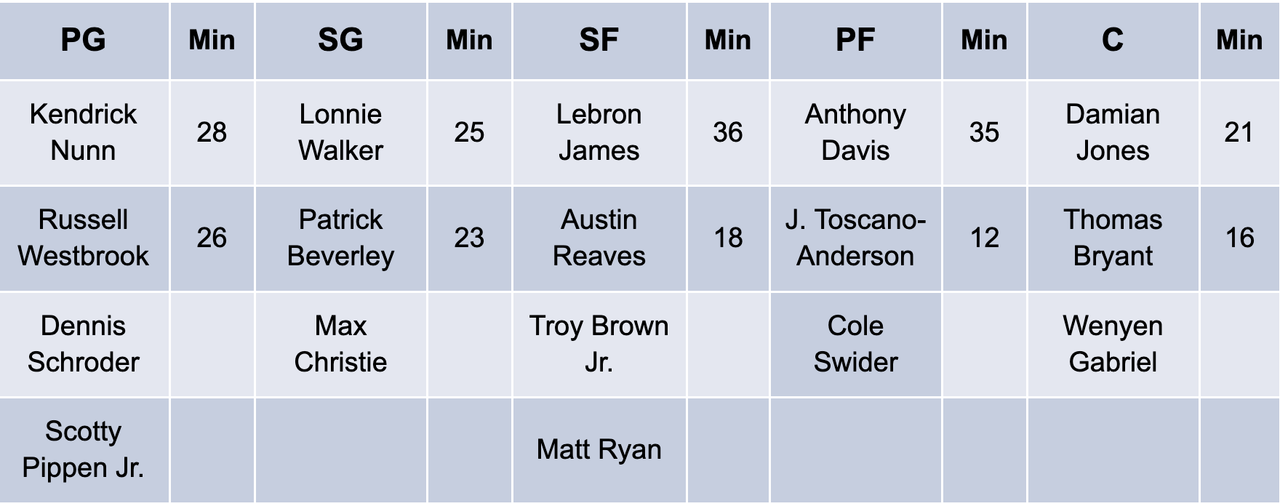
Best Case Scenario:
The Lakers found themselves relying on a two-way rookie and in-season signings and never fully meshed last season. There is hope they can correct the course. If Los Angeles can get 70 games out of Lebron James and Anthony Davis, then their floor exceeds that of last season. Solving the Westbrook dilemma by him accepting a different role or via trade will be beneficial. If Los Angeles employs two of the top ten players while deploying another five who understand and execute their roles, that recipe has more than proven to work countless times. While it might be a stretch to imagine them contending, the best version of the Lakers would still be a tough out in the playoffs.
Worst Case Scenario:
If the front office is unwilling to fully mortgage the future to offload Westbrook, then this arranged marriage should still be rocky. The rest of the role players raise suspicion: Dennis Schroder provides little value off the ball similarly to Westbrook, with only marginally better shooting. Patrick Beverley is 34 years old and should not play a large role. Kendrick Nunn has not contributed outside of the guard-friendly Heat system. Thomas Bryant is skilled but too immobile to defend or rebound at a high rate. Austin Reaves is a three-and-D player who just shot 31.9% from deep and didn’t defend at a high level. Damian Jones has not played for four teams in the last three seasons for no reason.
Davis has missed at least 20 games in each of the last four seasons and that trend figures to continue. James will turn 38 before the New Year and there is only so much that he should carry for an 82-game season. Optimistically, this season cannot play out as poorly as the last, but it could end up comparable.
What can they do with Russell Westbrook?
Westbrook has not proven to be malleable. While it would be nice if Westbrook harnessed his energy into playing his highest-level defense in a decade while becoming an average corner shooter who picks his spots, it does not feel likely. There is still some value to Westbrook’s game: he gets to the paint and finishes at a solid rate, and his rebounding and passing can be assets. Averages of 18.5-7.4-7.1 from last season should decline as Westbrook does not reach 34.3 minutes per game again, and the other two stars likely do not sit as much either.
If new coach Darvin Ham is unable to connect with Westbrook, then his time in the Lakers' starting lineup might be short-lived. There are too many other options to not explore that idea. Westbrook can excel as a sixth man, but that could be limited depending on how much they stagger his time next to James. If this bombs, then Westbrook might only be asked to play when James is off the floor. If he is unwilling to accept this, then he could be off of this team entirely. If a trade doesn’t materialize, then Westbrook either adjusts or faces a harsh reality.
Do any Lakers role players carry real fantasy value?
The most apparent candidate to add value is Nunn. While a knee issue made him unavailable for all of last season, he has looked strong enough in camp to position himself to start. If he does, then Nunn offers a higher ceiling as a role player than the other guard options. As a strong defender and plus shooter, he fits in seamlessly into the starting lineup and could average about 12.5-3.0-2.5.
Beverley and Schroder will also be contending for minutes at the guard position. Beverley would be more limited in his offensive role, while Schroder is redundant as a lead ball-handler. There is a lower chance of someone emerging in the frontcourt. While Bryant has been steady on a per-minute basis in his career, his scoring should be too sporadic and his rebounding too poor to be a good option. He has also been behind Damion Jones to this point, so it could be best to not invest in whoever earns a 20-minute role. Someone will emerge on this team, and the best bet is Nunn.
Memphis Grizzlies
Added: Danny Green, Jake LaRavia, David Roddy, Kennedy Chandler, Vince Williams (Two-Way), Kenneth Lofton Jr. (Two-Way)
Lost: Kyle Anderson, De’Anthony Melton, Jarrett Culver, Yves Pons, Tyrell Terry
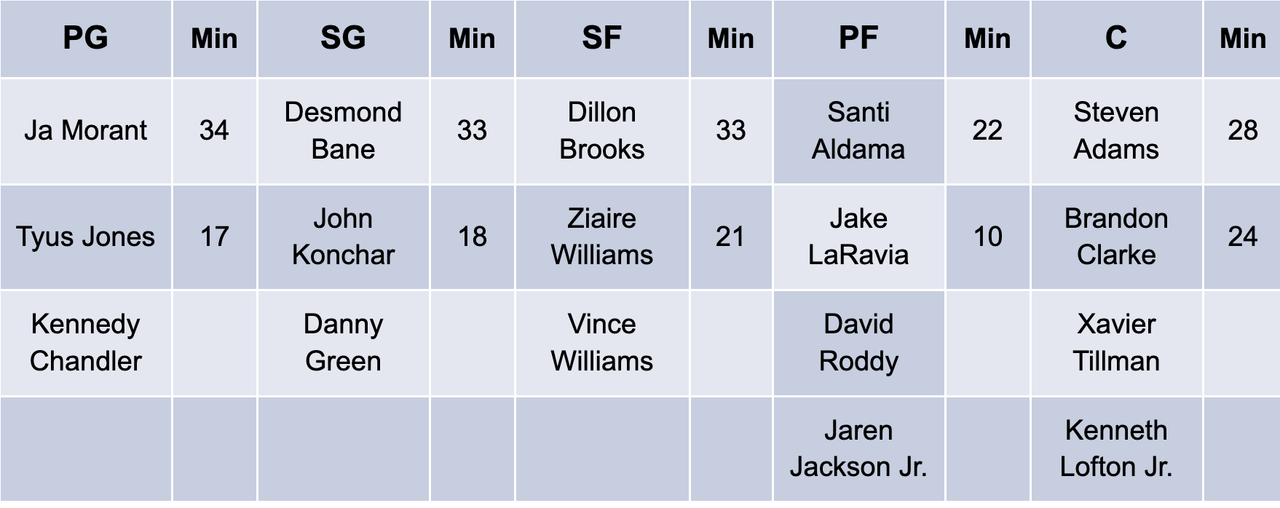
Best Case Scenario:
Memphis did not make big moves coming off of their breakthrough campaign, mostly adding rookies despite the losses of De’Anthony Melton and Kyle Anderson. If there is another step to go from second-round out to a real contender, then they do so purely on internal improvements. Ja Morant can continue to ascend, going from All-NBA to viable MVP candidate. Desmond Bane doubled his statistical production last season, and additional progression into becoming a Khris Middleton-caliber wing raises the ceiling of this team. Dillon Brooks simply needs to be more selective about his shots. Jaren Jackson Jr. will likely miss the first two weeks to two months of the season as he recovers from a stress fracture in his foot, and his full recovery this season is vital. If he progresses as a shooter and finisher, then the Grizzlies can make their next step.
Worst Case Scenario:
Taking a championship team to six games after 56 wins is a high bar, and this next step is the most difficult a franchise can make. Melton and Anderson were on the fringes of their playoff rotation, but they will be missed. Morant played in just 57 games last season before getting hurt again in the playoffs, and he takes a considerable pounding on his 174-pound frame. Jackson has missed 38% of his regular season games and enters this season recovering from a stress fracture. Bane enters his third NBA season already 24 years old, and it is fair to question if he is already scratching his ceiling as a player. Brooks will be 27 by mid-season, and his porous shot selection could be a part of his game that doesn’t get ironed out. Additionally, the Grizzlies’ wing and forward depth are largely untested. Getting more teams giving their all against them when they likely are not improved should hurt them during this campaign, and regression awaits.
Where does Jaren Jackson Jr. stand following off-season surgery?
Jackson has been often injured in his career but remained healthy last season. The 22-year-old curbed his foul rate and became even more impactful defensively, leading the league in blocks and collecting DPOY votes on the way to his first All-Defense selection. Jackson was the constant in Memphis’ lineup and anchored them when Ja Morant was sidelined. It felt like a key turning point for him and the franchise as he had been out of the lineup routinely in prior seasons.
That made it all the more disheartening when it was announced that Jackson would undergo surgery for a stress fracture in his foot. He should return anywhere from two-to-10 weeks into the season. Expect Brandon Clarke, Ziaire Williams, Santi Aldama, and a rookie forward to pick up most of his minutes for Memphis in the interim. But getting Jackson back near full health eventually is key. Expect him to work under a restriction and potentially accrue rest days for a period of time once he returns, which should limit his value for potentially half of the season. Key to his development is taking the recovery time for skill progression, as his jump shot regressed badly last season. If Jackson is able to return in full, with a better jumper to boot, then this is just a temporary setback.
Is Ja Morant due for statistical regression?
Morant has likely not reached his ceiling, and will continually progress at 23 years old. He was frequently unguardable last season, assumed a higher volume role, increased his shooting splits, and even improved defensively. He is one of the league’s brightest young stars, but to project statistical regression is not folly. It might be unavoidable based on what we have seen from the Grizzlies with healthy wings.
Morant’s stats with Brooks on and off of the floor were dramatic last season. In 45 games without Brooks, Morant averaged 29.1 points per game on 34.7% usage. In 12 regular season games with Brooks in the lineup, Morant was down to 21.3 points on 30.3% usage. Nobody believes in Dillon Brooks the way Dillon Brooks believes in Dillon Brooks, so it is not likely he suddenly accepts a reduced offensive role. Additionally, Brooks and Desmond Bane have proven to be largely durable over their careers, and it should be viewed as an outlier that either missed 50 games. Morant simply gets superstar usage with Brooks out, and merely star usage playing with him. Expect Morant’s scoring to decrease this season as a result of the Grizzlies having their full wing rotation available.
Minnesota Timberwolves
Added: Rudy Gobert, Kyle Anderson, Bryn Forbes, Austin Rivers, Eric Paschall (Two-Way), Luka Garza (Two-Way), Wendell Moore, Josh Minott
Lost: Jarred Vanderbilt, Patrick Beverley, Malik Beasley, Josh Okogie, Leandro Bolmaro, Jake Layman, Greg Monroe, McKinley Wright
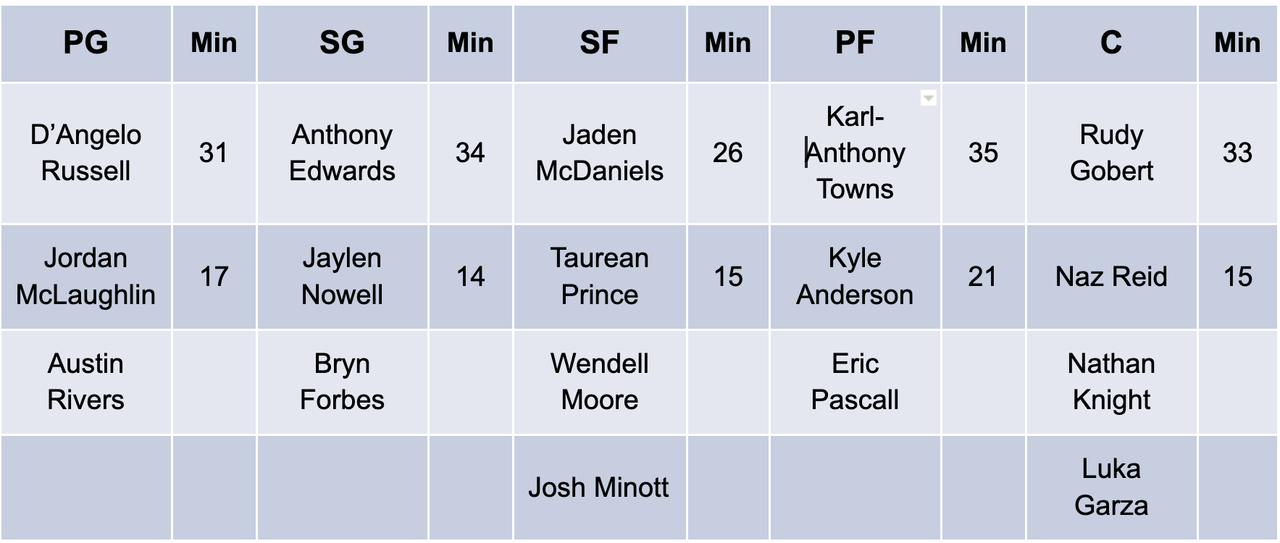
Best Case Scenario:
The Timberwolves went toe-to-toe in the playoffs with a 56-win team that threatened to topple the Warriors. Their biggest team weaknesses were interior defense and rebounding, and they acquired the best interior defender and rebounder in the league at the immediate cost of two fringe starters. Additionally, Rudy Gobert improves their offense, as they have lacked high-level screen setting and his gravity at the rim. Karl-Anthony Towns can shoot and defend in space well enough at the four to accommodate Gobert.
Anthony Edwards has made consistent noticeable steps in his game during his career, and he is still just 21 years old. If D’Angelo Russell can correct some of his faults and Jaden McDaniels, Kyle Anderson, and Taurean Prince manage not to lose games as role players, then this team is well-rounded. We have been ingrained to not take the Timberwolves or a Rudy Gobert-led team as a serious threat over time. But if these Wolves can approach being a top-five offensive and defensive team, is that not the blueprint for an eventual champion?
Worst Case Scenario:
The Wolves’ floor should be too high for the bottom to fall out, but that doesn’t mean they are a lock to reach their potential. To this point in their careers, neither D’Angelo Russell nor Anthony Edwards has been overly efficient scorers. While Gobert theoretically solves problems, he could create spacing issues, and the net impact of swapping him for Jarred Vanderbilt and Patrick Beverley defensively may not be substantially positive. Without standout perimeter defenders, Russell guarding more point guards than last season, and with Towns potentially overextended guarding forwards, the defensive effort still has issues. Overall, the Wolves have a higher floor and ceiling with Gobert, but it does not ensure that they have pieced together a true contender.
Does D’Angelo Russell help win games?
There were a couple of different points last season where coach Chris Finch opted for Jordan McLaughlin at point guard rather than Russell. That is a knock on Russell and not McLaughlin, who is a 5-11 guard who shot 31.8% from three. There were a couple of bad slumps for Russell last season that caused his shooting numbers to fall to early career levels, and it was at the worst that Finch decided McLaughlin was more likely to help his team. Entering year eight of the D’Angelo Russell experience, it becomes fair to question: can he be a starter for a team with NBA championship aspirations?
The greater amount of shot creation and distribution Edwards assumes as he develops, the less Russell handles those responsibilities matters. In a playoff series where Edwards and Towns demand more offensive touches, does Russell’s shooting negate his negative defensive impact? While Russell and Edwards had similar PERs last year, Russell’s true shooting percentage ranked near the bottom of the league, his 4.4 win shares placed him between Pat Connaughton and Javonte Green, and he was in the bottom eight percent of players who logged 1,500 minutes in defensive box plus/minus. Russell should be in the range of 18-3-7 again with less prolonged shooting slumps offsetting a slight usage reduction, but he needs to do more than that to prove himself to be a positive asset.
Can Anthony Edwards continue to progress?
Edwards’ rapid progression through his first two years and the sheer “wow” factor he brings suggest more room for growth. Edwards struggled out of the gate as a rookie, as an unsure role and learning curve led to averages of 13.4-3.1-2.0 per game on 36.8% shooting from the field in his first few months. Conversely, over the final 19 games of his rookie season, Edwards averaged 23.3-5.5-3.7 on 46.2% from the floor and 36.0% from deep—a massive in-season leap.
Year two followed a similar trajectory: through his first 60 games, Edwards kept pace with 21.0-4.7-3.7 per night on 43.2% shooting. His youth showed and a nagging knee injury had him out of the lineup, but he again managed to take another leap toward the end of the season. Throughout the Wolves' final 12 regular season games and six playoff games, Edwards averaged 23.9-4.9-3.9 per game on 48.1% from the field and 40.3% from three. If Edwards asserts himself and progresses linearly, he can maintain that over the course of a full season, likely minus a bit of efficiency. Edwards has evolved from a fringe NBA player to a bright young star and found another level of real All-Star play. And with his rapid improvements, progressing again and finding an All-NBA level of play is attainable.
New Orleans Pelicans
Added: Dyson Daniels, Dareon Seabron (Two-Way)
Lost: Tony Snell, Gary Clark, Jared Harper
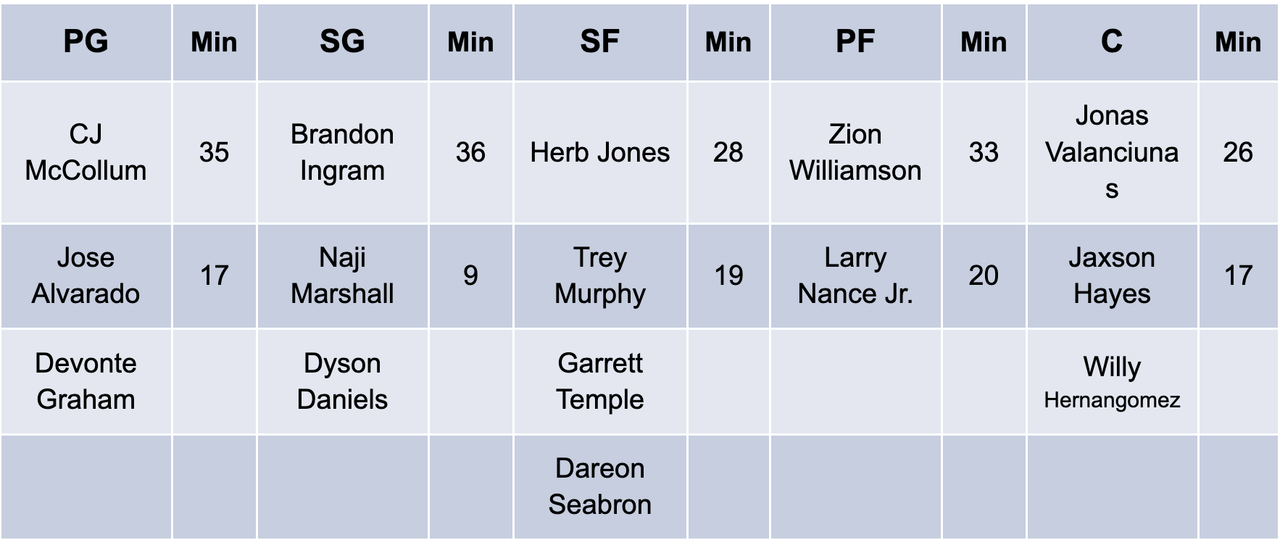
Best Case Scenario:
Following a 1-12 start, the Pelicans went 21-21 over the course of the next 42 games. Instead of tanking, they acquired CJ McCollum and proceeded to go 9-6 with him available next to Brandon Ingram. Thanks to the play-in tournament, the Pelicans secured the eight seed and took the Suns to six games, with two close losses in the series. If that is the baseline that they are able to add Zion Williamson back to and can count on improvement from their young core of Brandon Ingram, Herb Jones, Jose Alvarado, Trey Murphy, and Jaxson Hayes, then New Orleans might be trouble for the rest of the league.
Worst Case Scenario:
Reintroducing Williamson with little friction is the key element. If available, he makes them better regardless of his role. He has proven that he is best when on the ball as a primary facilitator, and working him back into this role when McCollum and Ingram did so well working off of each other is not a simple task. The wing pairing of Ingram and Williamson also proved to be poor defensively the last time they played together, and Jonas Valanciunas is even less mobile defensively than Steven Adams was at the time. This is a talented roster, but Willie Green has his work cut out for him to get this team up to its potential. With Williamson back in full, this team gets very interesting. Without him, we will likely see them in the play-in again.
Where does Zion Williamson’s health stand?
Williamson is set for opening night after taking nearly a full year to recover following a Jones fracture injury. Health does remain an issue, however, as the 22-year-old has now missed 66.3% of his games through three seasons. For a best-case scenario, project him playing roughly 60-68 games in the regular season with hopes that he is available come playoffs. Admitting Williamson’s health is an issue isn’t writing off what he can do with the rest of his career, but it does remain a major hurdle to overcome.
When Williamson returns, it is not likely that he is able to fully mirror his All-Star season stats. It should take him time to return to that level, and even then his role will not look the same. The additions of McCollum and Valanciunas should ensure that he shouldn’t get the same role. Additionally, while Point Zion will make its way back slowly, the same volume of opportunities to isolate and initiate offense should decrease. Expect minute restrictions and rest to potentially factor in the early season, too. To Williamson’s credit, he scored 27.0ppg on 29.3% usage when he was 20, which suggests that can produce while picking his spots around other talented players. He could reach 24-25ppg when fully healthy again.
Whose stats will Zion Williamson’s return impact most?
Williamson is not a ball-dominant guard who will completely interrupt the offensive flow, but the additional usage he reclaims comes at the expense of the rest of their offense. The obvious candidates to be affected are their two ball-dominant players in McCollum and Ingram. After McCollum was acquired, Ingram averaged 22.0ppg with 5.9 assists on 29.2% usage while McCollum averaged 25.2 points and 5.6 assists on 27.7% usage with Ingram. Either of them could attempt fewer shots per game, and their offensive ceilings are lower as a result.
Expect Williamson to affect Valanciunas more than the other stars. Valanciunas’ low post-scoring buoyed the Pelicans last season, and his career-high 17.8 ppg on 23.8% usage was important. The need for his post-scoring diminishes when Williamson is on the floor, however, and he could attempt a career-high number of threes in the interest of spacing. Additionally, Jonas is ill-fitted next to Williamson and Ingram defensively. Inserting a more mobile big like Hayes or Nance Jr. or even going small with a front court of Ingram, Jones, and Williamson could suit the Pelicans in a good amount of matchups. Valanciunas still has value, and staggering minutes to get him post touches on the second unit could be in coach Willie Green’s best interest. But expect his minutes and stats to decline because Williamson’s return negatively impacts Valanciunas more than any other Pelican.
Oklahoma City Thunder
Added: Eugene Omoruyi (Two-Way), Isaiah Joe, Chet Holmgren, Ousmane Dieng, Jalen Williams, Jaylin Williams
Lost: Isaiah Roby, Jaylen Hoard, Zavier Simpson, Georgios Kalaitzakis, Melvin Frazier, Derrick Favors, Theo Maledon, Ty Jerome
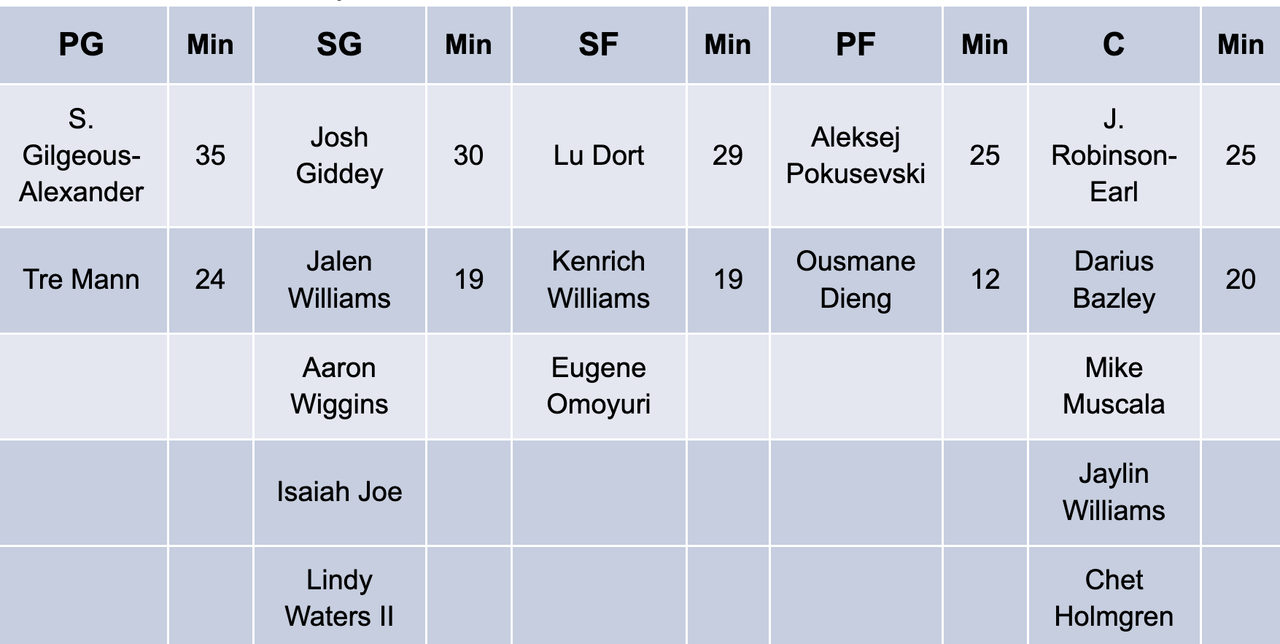
Best Case Scenario:
In the bigger picture, you can see how the main pieces of their young core can potentially fit together for a championship team. Shai Gilgeous-Alexander can become the second-best player on a contender based on his All-Star level play in his age-23 season. It is not inconceivable to look at how Josh Giddey played as a rookie and imagine how he could have a Manu Ginobili-like impact in his respective prime. Chet Holmgren’s rookie season has been lost, but he could be the second or third-best player on a contender. Lu Dort can also prove himself to be one of the premier three-and-D players in the league and Tre Mann one of the most electric bench scorers. If the Thunder’s young talent continues to progress while dipping into the lottery for one last franchise piece, then Sam Presti will have created a second championship window.
Worst Case Scenario:
The Thunder have accumulated enough talent that it is impossible for it all to fit together already. Gilgeous-Alexander and Giddey are the primary distributors, and players like Mann, Jalen Williams, and Dieng will not get the necessary reps to progress outside of the G-League. Dort, Pokusevski, Bazley, and Robinson-Earl operate off-ball, but they could be cast into roles too specific for their offensive games to sufficiently progress. If the Thunder have too many players and the last three seasons have permeated a losing culture, then stagnant growth from a lot of their young talent is possible. Additionally, Stagnant growth from those with less assured opportunity is even more likely. Oklahoma City is reaching the most tricky part of its rebuilding plan, and they could potentially be in trouble if there are too many pieces.
Will this be the first Shai Gilgeous-Alexander All-Star season?
Gilgeous-Alexander has displayed All-Star-level talent for a couple of seasons, but it has been lost amidst middling Thunder campaigns. In his age 22 and 23 seasons, Gilgeous-Alexander has hovered around 24-5-6 nightly, with versatile defense and mostly respectable shooting splits. No All-Star buzz built for him because stats on bad teams are readily dismissed, and it is easy to forget how impressive Gilgeous-Alexander has been as a result. Those numbers existed despite him being shut down prior to easier late-season games, and this could be the season where the national media acknowledges Gilgeous-Alexander’s development.
Gilgeous-Alexander could continue to operate in relative anonymity as a result of this team being difficult to sell to the average fan. It’s possible that his stats decline with fewer forced shots and assist opportunities on a more balanced team. That factor should help his almost 12% decrease in his three-point shooting, but it lowers the ceiling for his stats. Overall, Gilgeous-Alexander can assemble the 22-5-6 lines he has established as increased efficiency can balance out some slightly lesser volume. He is still the lead scorer, and if he can take steps while leading a 30-win team instead of a 20-win squad, then he could receive some overdue respect.
Does Aleksej Pokusevski have fantasy basketball value?
Pokusevski has spent more time with the Oklahoma City Blue than the NBA team over his first two seasons, but he should not be discounted. In fact, this could be the season where he demonstrates his worth. Pokusevski is still just 20 years old and added 20 pounds to his seven-foot frame over the course of this last year. He has largely been forced to play on the wing, and his maturation should allow him to fill in at power forward. It did not take long in training camp for this opportunity to come to fruition, and Pokusevski does appear to be primed to seize a starting role.
If Pokusevski earns and retains a starting role, then should be firmly on the fantasy basketball radar. His playmaking from the end of last season was a revelation, as he contributed 5.9 assists per game in his last ten appearances. Pokusevski’s rebounding should also be improved, and he already added 7.3 rebounds per game in his final 20 appearances. While his passing and rebounding are promising assets, it is his shooting that will allow him to keep a starting role. Pokusevski’s shot looks good, but his shot selection has been poor and has resulted in sub-30% shooting from deep. There is no guarantee that Pokusevski shoots and defends at an acceptable level, but he could end up averaging 10.0-6.5-.3.0 for much of this season with the potential for more once the Thunder eventually tank at year’s end.
Phoenix Suns
Added: Damion Lee, Jock Landale, Josh Okogie, Duane Washington Jr. (Two-Way)
Lost: Jae Crowder (pending), JaVale McGee, Aaron Holiday, Elfrid Payton, Gabe Lundberg
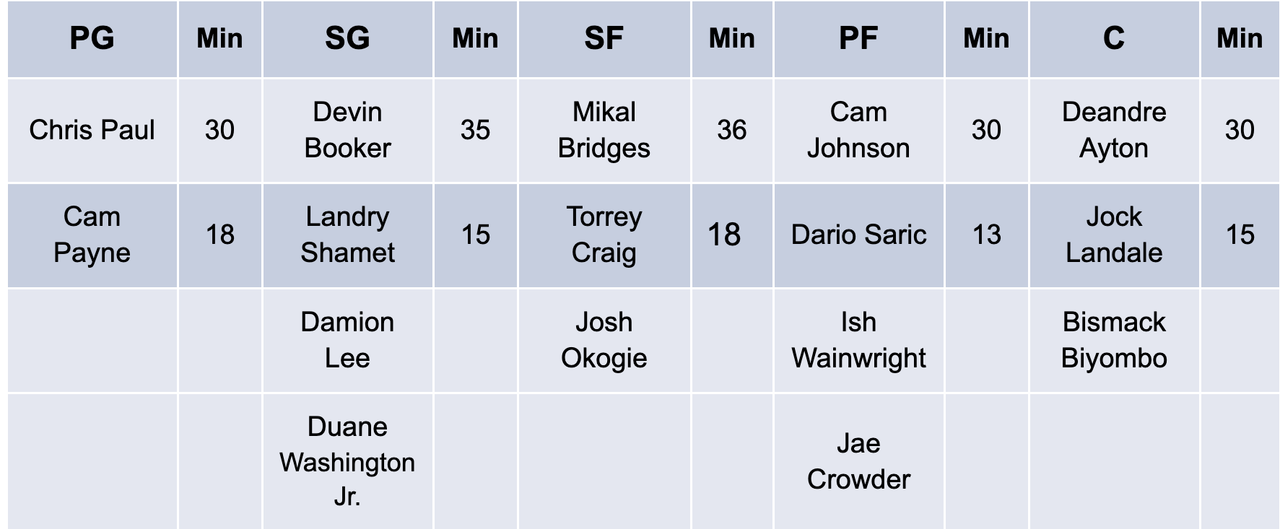
Best Case Scenario:
The Suns must prove they are the team that won 64 games last season and not the team too hobbled in the playoffs to deliver. They retained most of their roster in an attempt to prove this. Paul needs to stave off further regression at 37 and be sharper than he was during the playoffs. Their ceiling will be raised further if Deandre Ayton, Cam Johnson, and Mikal Bridges improve offensively as they should at this stage of their careers. Their ceiling will be maxed if Devin Booker, still 25, can further progress following First Team All-NBA honors. Phoenix is gambling that last year’s playoffs were an aberration with their main core another year closer to their career peaks.
Worst Case Scenario:
There is a credible argument to be made that while Phoenix is a good regular-season team, their talent doesn’t match their resume. Booker might not be one of the league’s ten best players. It was also very telling that Ayton was a free agent for nearly three weeks before the Suns had a contract to match for him. Paul just averaged a career-low 14.7ppg, and his ability to exert his will should be further diminished. Cam Payne proved last season that he is not the third guard Phoenix requires as Paul ages, and none of Landry Shamet, Torrey Craig, or Dario Saric move the needle for them in a positive way. It is easy to see a second-round playoff exit for the Suns again.
Does Chris Paul need to do less during the regular season?
While his scoring decreased last season as his outside shot suffered after a thumb injury, Paul led the league in assists. He is still an All-Star quality player when fresh. But Phoenix will need Paul at his best this postseason because that has not been the case during the previous two. The Suns won games one and two against the Mavericks with Paul playing well but lost four of five when his hamstring didn’t hold up. Phoenix goes as he goes, and he needs to remain sharp.
In order for Phoenix to keep Paul fresh, they cannot push him in the same way. He has avoided regular rest, missing an average of only 13.6 games in the last three seasons. Additionally, he no longer needs to play nearly 33 minutes per night before the playoffs. It is likelier than not that Paul rests regularly this year, and he should not exceed 64 games. His fantasy value decreases if that becomes the case, and he also carries less value with a slightly reduced minute load. Look for his scoring to remain static if his outside shooting recovers, but his assists fall off from an elite level. Also, if the Suns can acquire a combo guard, Paul’s burden can be eased during less meaningful games. There is a smart way to play Paul this season, and he should be less valuable in fantasy ball as a result.
How can Cam Johnson produce in a starter role?
Johnson is set for the largest role of his career. With Jae Crowder being extension-eligible at 32, Phoenix signaled that it was time for Johnson to start at power forward. With an extension and a starting role off the table, Crowder is seeking a trade as the Suns move forward with granting Johnson that opportunity. This will be the first season he regularly plays a full load of starter minutes, and career-best numbers await.
Johnson has improved each season and proven his value. While there have been improvements in every facet of his game, Johnson’s shooting has reached elite levels. His 42.5% from deep ranked fourth in the league, and he should be ready to take a higher volume. Johnson’s offense is valuable to the Suns, and his 16.1ppg with Booker injured was second on the team. His shooting makes the Suns more dynamic, and his counting stats should rise as he exceeds 26.2 minutes per game. Additionally, Johnson and Bridges are expected to initiate more offense this season, which should increase their usage and facilitating stats. Envision Johnson reaching 30 minutes per night on higher shooting volume, with averages of 14.5-5.0-2.0 being attainable.
Portland Trail Blazers
Added: Jerami Grant, Gary Payton II, Olivier Sarr (Two-Way) Shaedon Sharpe, Jabari Walker
Lost: Eric Bledsoe, Joe Ingles, Ben McLemore, Reggie Perry, Elijah Hughes, CJ Elleby, Kris Dunn, Keljin Blevins, Didi Louzada
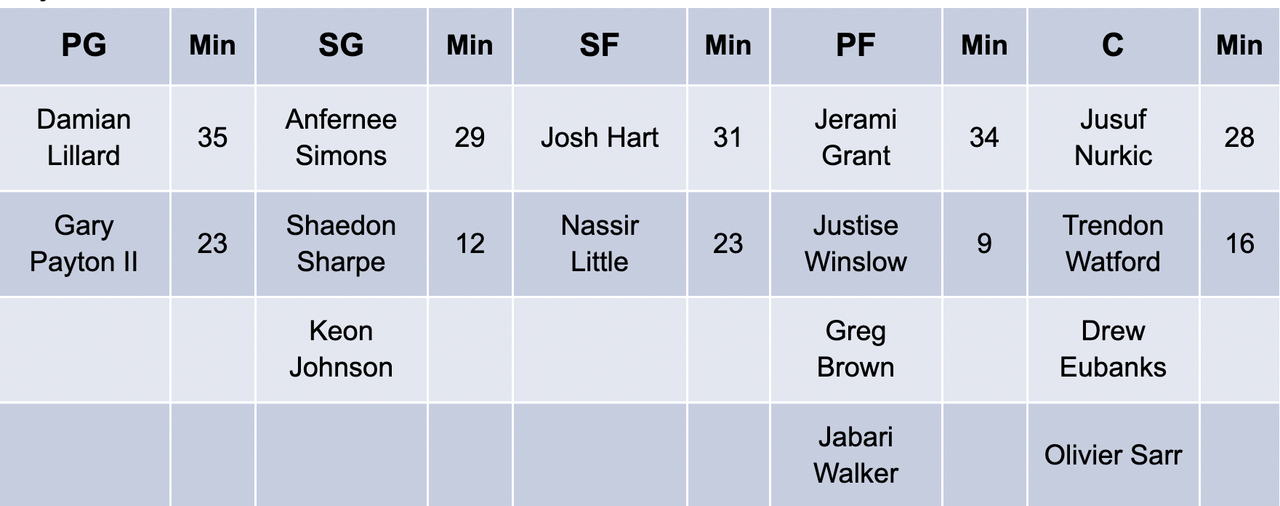
Best Case Scenario:
Portland has done a good job re-tooling with few assets. On paper, this team is no worse than they were with CJ McCollum, and they could potentially surprise. Many variables need to go their way in order for that to happen. Damian Lillard took a clear step back in his age-31 season, but nagging injuries could have been the culprit. Jerami Grant doesn’t necessarily fit cleanly, but he is still a standout defender and could fit nicely if his three-point shooting remains above 36%. Anfernee Simons has made a noticeable improvement every season, and he can potentially approximate McCollum’s production. Josh Hart, Gary Payton II, and Jusuf Nurkic figure to fill their roles capably, and if Nassir Little can solidify himself as a role player coming off shoulder surgery, then Portland is as solid 1-7 as they have ever been with Lillard.
Worst Case Scenario:
Lillard’s statistical decrease was tied directly to sharp drops in his shooting numbers, and if those don’t recover, then this next chapter gets ugly. Now 32 years old, Lillard is due at least $42 million over each of the next three seasons. Simons lit the league up with 23.4 ppg on truly impressive shooting splits over the final 27 games of last season, but if he is not the same player during more competitive basketball, then Portland just handed Jordan Clarkson $100 million. Additionally, a Lillard-Simons backcourt could be the league’s worst defensively. Nurkic was given $70 million coming off of three seasons in which he could not play more than 56 games, and the backup centers are questionable. The Trail Blazers could end up being a very expensive team struggling to tread water in the middle of this league.
Is Damian Lillard past his prime?
At just 31 years of age, Lillard was not scheduled for a sharp decline. He looked like the same player and functionally made the same moves with the same shooting volume, but the shots did not fall with the same precision. After hovering around 39-40% from deep on heavy volume over the prior two seasons, Lillard dropped all the way down to 32.4%. This was the biggest catalyst for his overall field goal percentage dipping to 40.2%. As a result, the season was lost before Lillard opted to receive season-ending surgery on a lingering abdominal muscle injury.
He stated that he aggravated the issue while playing with Team USA in the Olympics, and the truth is that Lillard played a ton of basketball in the last year and a half prior to the surgery. Once bubble play commenced, Lillard played 114 NBA games in a year-and-a-half span, plus all of his Team USA work. He wore himself down and did not allow proper recovery time from nagging injuries.
Optimistically, Lillard can return to the 29-4-8 All-NBA player pre-injury at the end of his prime. Pessimists believe that while recovery can get him back to even 90% of his production, the toll of his career places Lillard outside of his prime. Lillard’s statistical floor is likely 24-4-7 based on volume alone, but exceeding those projections depends on if the optimists or pessimists are correct.
Do Portland’s tertiary scoring options lack upside?
While there are certainly questions surrounding Lillard regaining his All-NBA form, his shooting volume projects to remain the same. This leaves the rest of their players competing for usage slices. There are seven core players for a healthy Blazers team, and only two of them—Little and Payton II—project as low-volume role players. A logjam of Simons, Grant, Hart, and Nurkic may not receive as many shots as they feel they deserve.
We’ll create a rough model of the Blazers' volume. With a similar pace to last season, they will attempt roughly 90 field goals per game. Over his prime, Lillard has consistently taken 19-20 field goals nightly. At the backup center and wing positions, we estimate a rough eight shots per night for the combination of Trendon Watford and Shaedon Sharpe/Keon Johnson. Little and Payton II are cast into lower usage roles, and we can conservatively project them to combine for 13 shots. Nurkic has generally averaged between nine and 13 shots per game in Portland, and he can be penciled in for a low-end average of 10. Working backward, this leaves only roughly 37 shots for the trio of Simons, Hart, and Grant. Projecting Hart on the low end for nine leaves 28 shots remaining for Grant and Simons. Each of them is a bit overrated for the opportunity that they will likely have as a result. Expect Simons to hover around 16-17 ppg with relatively few other stats and for Grant to come in around 16, ultimately capping their value.
Sacramento Kings
Added: Malik Monk, Kevin Huerter, Keegan Murray, KZ Okpala, Chima Moneke, Matthew Dellavedova, Keon Ellis (Two-Way)
Lost: Donte DiVincenzo, Justin Holiday, Moe Harkless, Damian Jones, Jeremy Lamb, Josh Jackson. DJ Steward
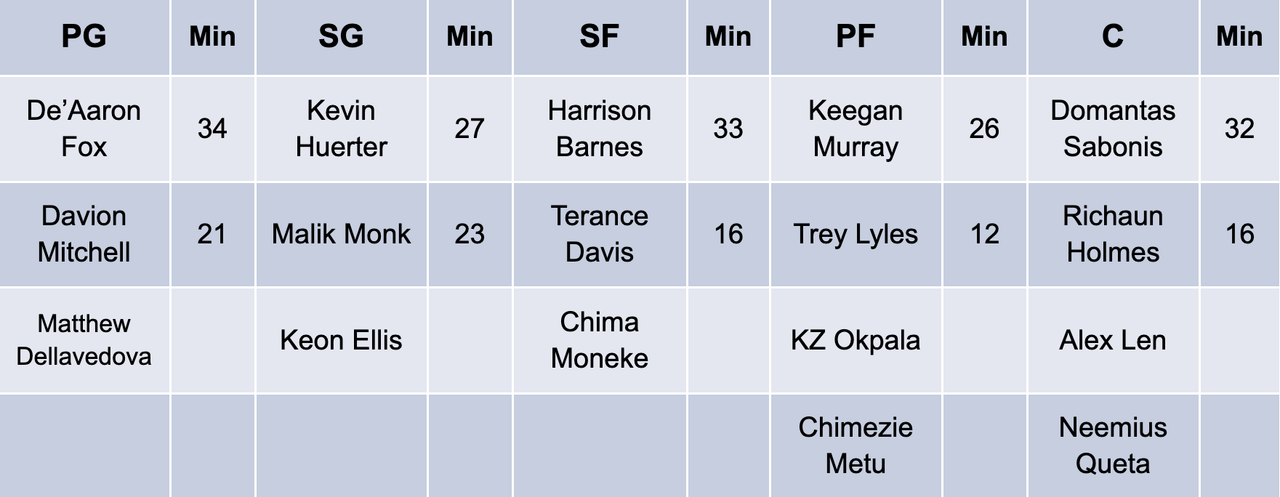
Best Case Scenario:
Team governor Vivek Ranadive has been at the helm for nearly ten seasons, and the best record that his team has posted—by a six-win margin—was a 39-43 effort in the 2017-2018 season. By their standard, making the playoffs this season is a success. De’Aaron Fox and Domantas Sabonis will need to play at near All-Star levels to anchor them. Davion Mitchell, Malik Monk, Terance Davis, Trey Lyles, and Richaun Holmes sneakily form one of the best handful of bench units in the league. If Kevin Huerter and Keegan Murray can fill needed roles, then the end of their playoff drought could be in sight. Coach Mike Brown has his work cut out for him with Barnes and Mitchell being their only quality defenders. But if he can elevate their defensive effort past the sum of their parts, then this will be the best Ranadive Kings team to date.
Worst Case Scenario:
Brown has proven to be an effective defensive coach in the past, but the pieces are probably not in place for this to be even an average defensive team. Fox has never reached his capabilities as a defender, and Sabonis is too slow and short-armed to effectively anchor a defense. If Brown opts for a drop scheme to make up for Sabonis’ deficiencies, then only Harrison Barnes is a capable enough wing defender to enact that decision. Offensively, they will be exciting playing through the Fox-Sabonis duo and are surrounding them with capable shooters. It’s likely that Sacramento finds itself in shootouts often this season, and their odds of winning over half of those are not as high as they would like.
Is the post-Haliburton version of De’Aaron Fox here to stay?
The Kings were panned for trading their only good draft pick of the last four years, and Tyrese Haliburton’s success in Indiana underscored that. But quietly, not sharing the ball with Haliburton and developing chemistry with Sabonis amplified the best in Fox’s game. In his last 16 games of his season, before he was shut down, Fox averaged 28.9-4.3-6.8. More impressively, he did so on 50.3% from the field and 38.0% from deep. Fox’s best-case version was on display after the Haliburton trade last year.
Mike Brown could slow the pace of play for the Kings. Huerter, Murray, and Monk have been added, and Terance Davis is back from injury. The light will not be as green for Fox as it was towards the end of last year when he carried a 30.9% usage rate. But clearly, something flipped when Haliburton exited: this was Fox’s team and his aggression in driving to the basket and launching threes surged. If that confidence persists, and if chemistry with Sabonis eases his workload, we might be set for a career season for the 24-year-old. The key will be the sample of his shooting, as he has still had below-league-average efficiencies. But if his marksmanship can roughly translate from his six-week tear, suddenly Fox is a more complete player. The numbers likely remain stable around 23-4-7, but the path to get there could help the Kings win a good deal more.
Can Domantas Sabonis finally be used in the correct way?
We have seen flashes where Sabonis has been thrust into a Nikola Jokic-esque role and it pays off. Sabonis is not on Jokic’s level as a shooter, but that is not an insult to him. Sabonis is an asset in his screen setting out of the high post, but he can really make an offense hum when allowed to distribute there. Basing their offense around the central action of a Fox-Sabonis screen and roll, flanked by shooting, should prove effective. Initiating more offense through Sabonis could cause this to be the most productive season yet for the 26-year-old.
Sacramento did not pay a premium to acquire Sabonis to not maximize his full potential, and Brown would be right to incorporate more of these opportunities. Additional facilitating work and starting opportunities at center open the door for career highs in rebounds and assists. Look for Sabonis to clear 12 boards per game with ease and for his assists to potentially match the 6.7 per game he had during his second All-Star season. In the world of fantasy basketball, there will be few players better than Sabonis if he lives up to capable 20-12.5-6.5 marks.
San Antonio Spurs
Added: Isaiah Roby, Jeremy Sochan, Malaki Branham, Blake Wesley, Dominick Barlow (Two-Way), Jordan Hall (Two-Way)
Lost: Dejounte Murray, Lonnie Walker, Jock Landale, Joe Wieskamp, Devontae Cacok, Robert Woodard, DJ Stewart
Potential Cuts: Joe Wieskamp
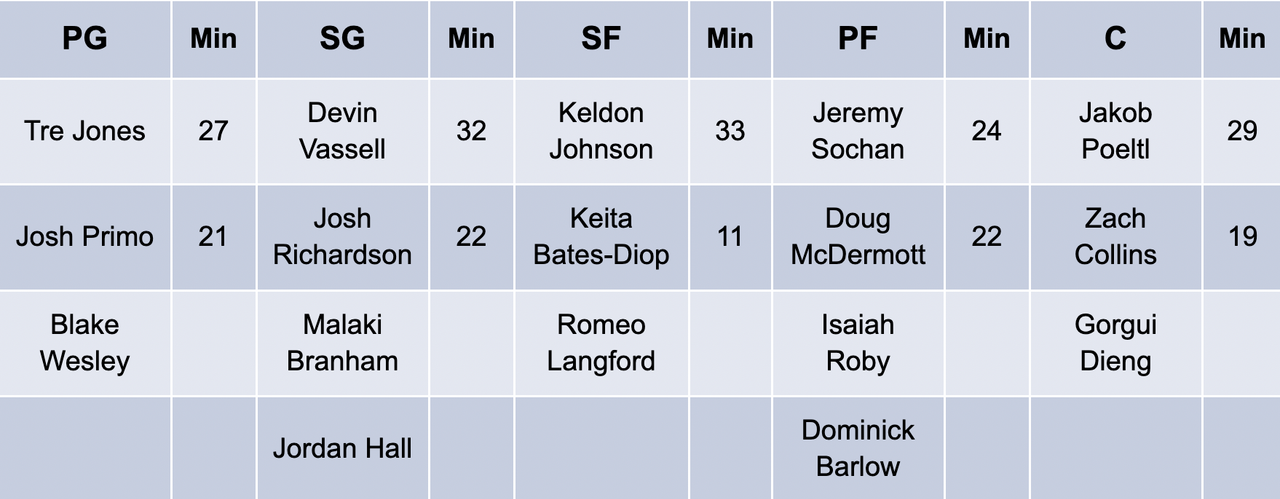
Best Case Scenario:
The Spurs' success should be based on the growth of their young core now that they have committed to a rebuild. Keldon Johnson must prove he can be more than a tertiary offensive option after his contract extension. Devin Vassell needs to prove that he can create off of the dribble. Tre Jones needs to prove himself now that he has been given a green light to grow in his new role as a starting point guard. While they are extremely young, the trio of Josh Primo, Malaki Branham, and Blake Wesley establishing themselves as building blocks are key for the Spurs’ long-term health. Jeremy Sochan flashing consistently in year one is also vital. If Zach Collins or Isaiah Roby prove to be something this young San Antonio team can build with, then even better.
Worst Case Scenario:
The worst case scenario for San Antonio is stunted growth from their young talent: Johnson and Vassell proving to be inefficient when he needs to force the issue. Jones unsuccessfully creating for others while shooting as poorly from deep as he did last season. Sochan looking more like Al-Farouq Aminu than OG Anunoby on the early returns. Branham, Primo, and Wesley failing to flash outside of the Austin Spurs. If they don't manage to recoup any assets for Josh Richardson and Jakob Poeltl all while winning just enough games to not position themselves at the top in the lottery, then that is a fairly significant setback for the rebuild.
How much can Keldon Johnson carry this offense?
The Spurs will still be a competent defensive team with their personnel and Pop at the helm. Offensively, they will fall behind the rest of the NBA. With Dejounte Murray gone along with Lonnie Walker, there is a fairly big hole to fill at the AT&T Center. And there are only so many plays that can be run for Doug McDermott offensively. San Antonio’s personnel, their offseason moves, and a four-year, $74 million extension signal that all of the opportunity in the world is going to be present for Johnson as their primary option for creating shots entering his fourth NBA season.
Johnson’s opportunity resembles Jerami Grant’s situation with Detroit two seasons ago. Similarly to Johnson, Grant was a role player for the start of his career before entering an environment where he needed to create off the dribble more than was ever asked of him. Grant nearly doubled his statistical output as a result of the opportunity, going from 12.0 ppg to 22.3 per night as he shot with impunity despite converting at a 42.9% clip. In an 11-game sample without Dejounte Murray last season, Johnson averaged 16.0-5.5-2.9 per game. With the growth in his age-23 season, stats of up to 20-6-4 are attainable and he should be further up the fantasy radar.
How much can Tre Jones produce in this opportunity?
San Antonio’s front office moved Murray when it became clear that they were unable to offer him anything near market value following last season. They did so without retaining any players from that trade, and they also did not acquire any other lead guards. With their old floor general gone, there are limited options remaining. Richardson can function in that role at times, but the 29-year-old is not a piece of this franchise’s future. Wesley and Primo are teenage combo guards still learning how to lead an offense. They may very well receive a portion of the point guard role this season, but neither should start there until after the All-Star break. The only point guard remaining on this roster is 22-year-old Tre Jones, and it appears that he will be given a full starting role.
Jones has shown flashes to this point, but projected starting point guard is quite the promotion. In his second season last year, he was the backup point guard for the first time. He frequently looked like his brother when on the floor: a standout defender and heady player whose assist-turnover ratio was second in the league behind only Tyus. It is not a surprise to see Jones be given a larger role by a coach who values Jones’ strengths more than others. We saw flashes of what this season can look like when he started 11 games late last season: 13.5 ppg, 4.6 boards, and 7.5 assists per night. If his shooting bounces back from the atrocious 19.6% he shot from deep and he improves at self-creation, then there could be an upside for more as well. With the opportunity presented to him, the younger Jones brother is relevant everywhere in fantasy ball.
Utah Jazz
Added: Lauri Markkanen, Collin Sexton, Ochai Agbaji, Jarred Vanderbilt, Malik Beasley, Leandro Bolmaro, Talen Horton-Tucker, Kelly Olynyk, Micah Potter (Two-Way) Walker Kessler, Johnny Juzang (Two-Way), Simone Fontecchio
Lost: Donovan Mitchell, Rudy Gobert, Bojan Bogdanovic, Royce O’Neale, Hassan Whiteside, Eric Paschall, Juancho Hernangomez, Trent Forrest, Danuel House, Xavier Sneed
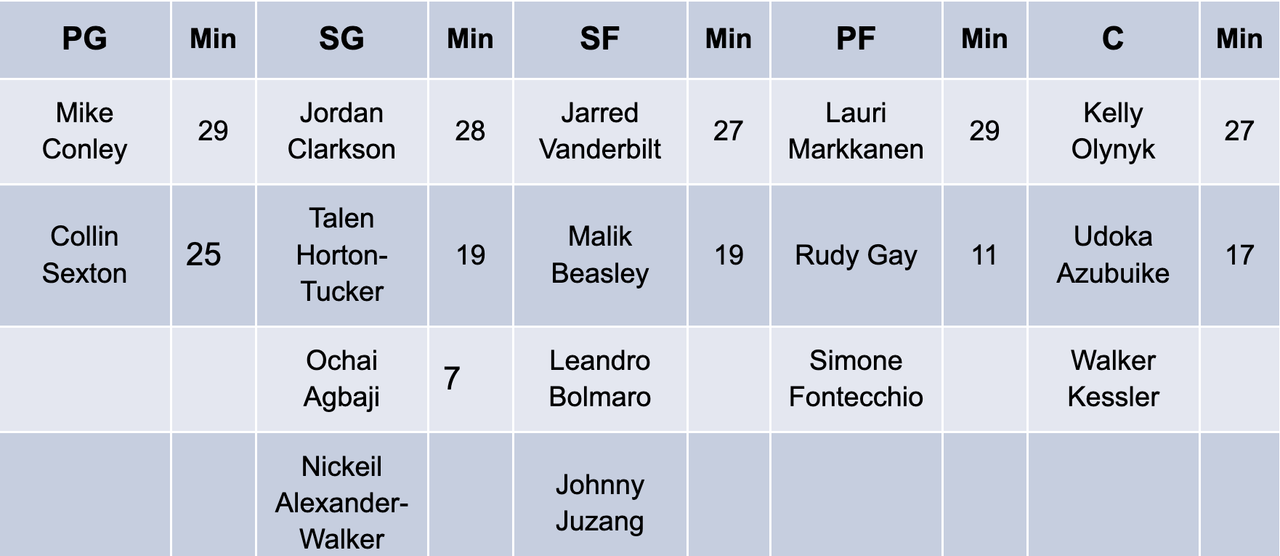
Best Case Scenario:
The Jazz are fully committed to a rebuild. While Mike Conley and Jordan Clarkson remain on the roster, recouping assets for vets remains essential. The largest emphasis should be placed on developing young assets. The light should be green for Collin Sexton, and if he can find a way to mimic his 2020-2021 season after a lost campaign, then that is a positive sign. Horton-Tucker, Ochai Agbaji, and Nickeil Alexander-Walker are flawed, but that doesn’t mean they can’t prove to find a place in the league. Jarred Vanderbilt could prove to be one of the most impactful defensive forwards in the league and no longer be an offensive zero. The inverse could be true for Lauri Markkanen. It is unclear if Utah would like to retain any of these current players by the time they are ready to compete around 2026, but finding a couple of them while they get a high lottery pick would be ideal.
Worst Case Scenario:
The worst-case scenario for the Jazz involves them actually winning more games than expected. An average offense is possible with their current rotation. And while the defense will be bad, coach Will Hardy could piece together competency. If Conley, Beasley, and Clarkson all play for most of this season and are not traded, then they’ll block minutes and opportunities. Sexton will get his minutes, but Horton-Tucker, Alexander-Walker, Agbaji, and even Jared Butler getting reps could be valuable long-term. Additionally, if Udoka Azubuike and Walker Kessler do not flash in their opportunities, then they have nothing at center moving forward. The big dominos in this rebuild have fallen, but the rest need to continue in order for them to maximize what they can extract from this coming season.
Are Lauri Markkanen and Kelly Olynyk valuable?
25-year-old Lauri Markkanen has never quite found the right role, but Utah set him up nicely on his third team. Defensively, he needs to take the easy forward assignment while Vanderbilt does the hard work. Offensively, he should be very involved while Vanderbilt does little. Markkanen is effectively stepping into Bogdanovic’s spacing role that was recently good for 18.1ppg on 23.7% usage, and Markkanen could be used even more. If Conley plays significant minutes and facilitates Markkanen, then a path exists for him to match his career-best 18.7ppg on 25% usage. Consider 17.0-7.0-1.5 projections as the move to Utah provides a boost to his overall upside.
Olynyk could be set up for an even bigger boom on his new team. The other Jazz centers have played a combined 32 games and shouldn’t present a threat to his role until after the All-Star break. Vanderbilt will likely play some center minutes, but that time is limited for the 214-pounder. Expect Olynyk to play at least 24 minutes per night in a starting role, with more being likely. His per-36 numbers from the Pistons or Rockets shouldn’t be matched in a different role, but there is room for him to post roughly 14.0-7.0-3.5. This leaves Olynyk’s floor as a worthy draft pick with the upside to be a real steal. There is a lot in flux on this Jazz team, but if Jordan Clarkson departs before Mike Conley, then their two new frontcourt players are situated nicely.
Is Collin Sexton an underrated fantasy basketball asset?
Most NBA fans have not thought about the 2020-2021 Cavaliers since the day their season ended. That team is relevant now because a similar dynamic can play out for this current Jazz squad. Most either forgot or did not realize how good Collin Sexton was for that forgettable Cavs team, and he will be given a similar opportunity to carry another lottery-bound squad. During that season, Sexton posted 24.3-3.1-4.4 averages on 47.5% from the floor and 37.1% from deep. For a 22-year-old carrying a bad team, his scoring efficiency was really impressive.
While Sexton will not be able to reproduce Donovan Mitchell’s 33% usage, Sexton could reach his peak 29.6% mark provided the Jazz make additional roster moves. If Jordan Clarkson in particular is traded, then he can realistically replace 80% of Mitchell’s scoring production in a similar role. That could be good for an average of 20 points per game. Currently, his sixth-man role should raise his assist numbers, but he might be limited to closer to 16-17 points per game in that role.